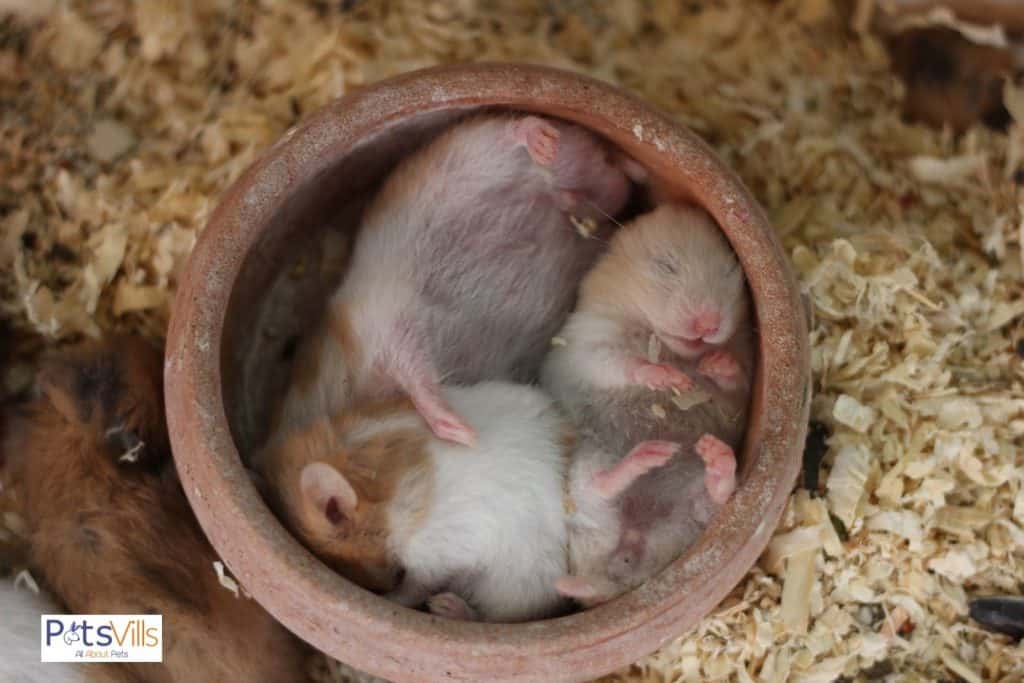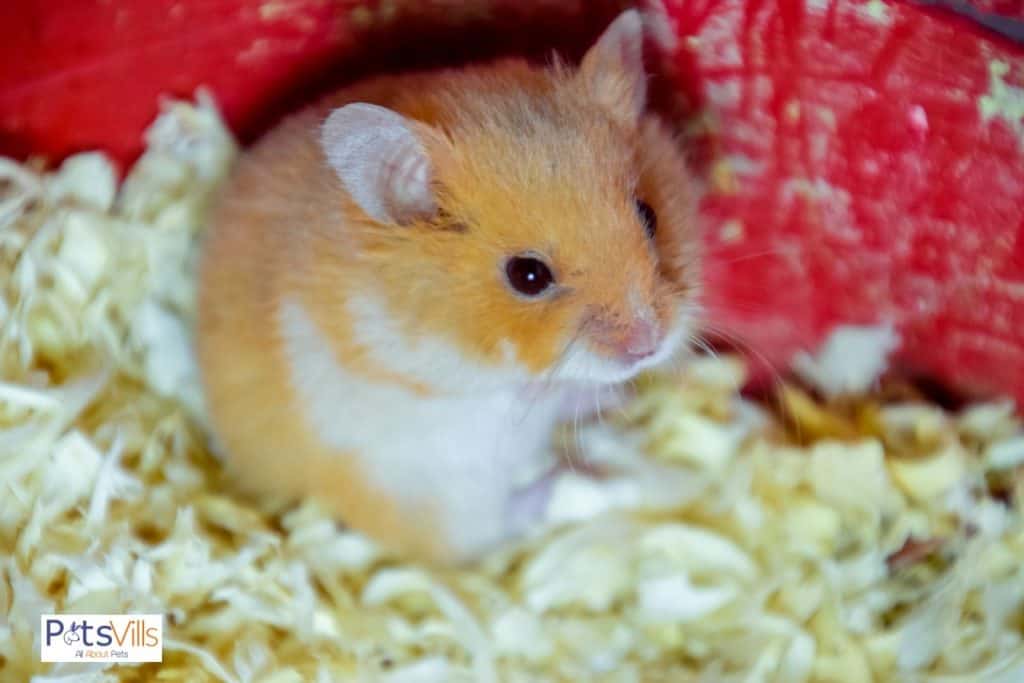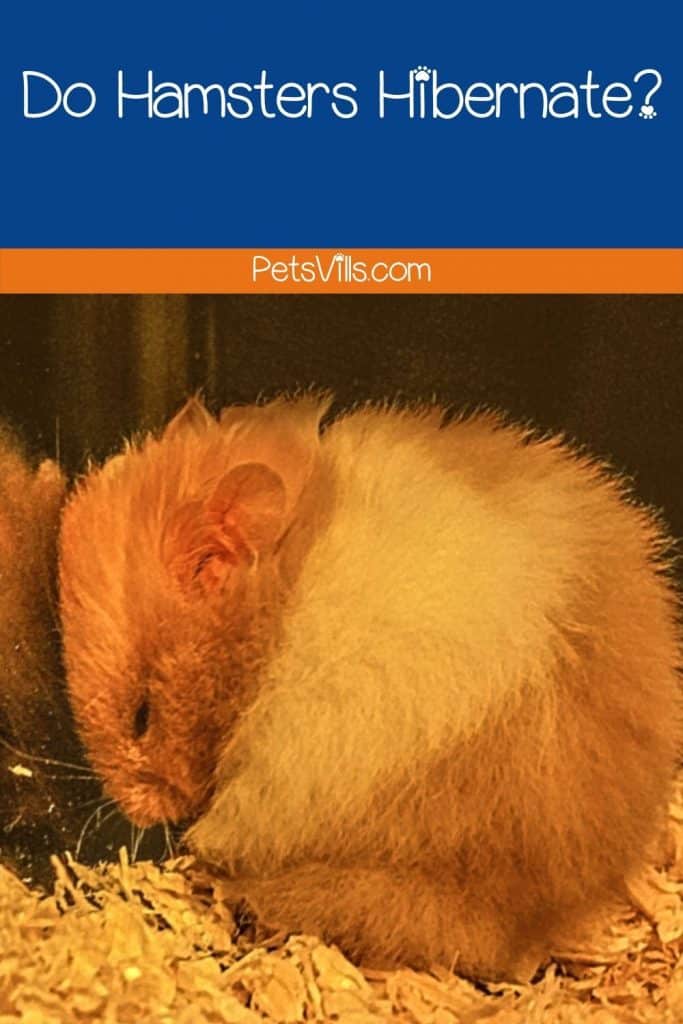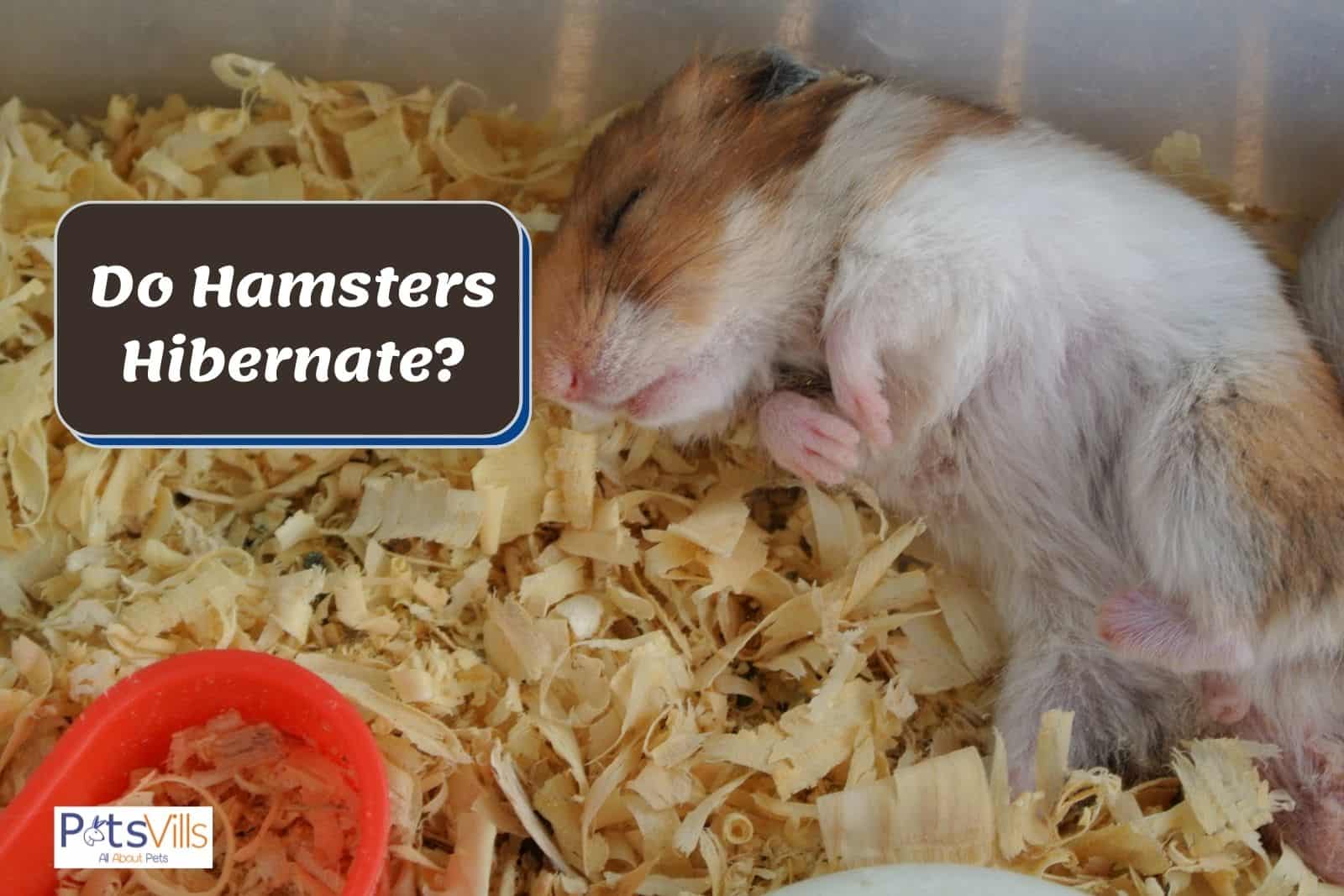Dear Hamster Owner, if you’re seeking assistance because your hamster is not moving, rest assured, we’re here to help. A common misconception, particularly among owners of young and healthy hamsters, is mistaking their state of inactivity for death when it could very well be hibernation.
Many pet owners come to us with this particular question: ”Is my hamster dead or hibernating.” Our advice? Don’t worry just yet – it’s quite likely your hamster is simply hibernating.
To be sure, there are four key signs to look for. If your hamster shows these signs, it’s a strong indication that they’re hibernating and not in any danger. Check these signs to understand if and how long your hamster might be hibernating, giving you peace of mind about your furry friend’s health.
FYI, this post contains affiliate links. I may earn a small commission if you purchase at no extra cost.
Table of Contents
Table of Contents
Get Your Own Hamster Owner’s Handbook!
So, do hamsters hibernate?

Yes, pet hamsters will start to hibernate when the temperatures go too low or if their food supply is low, and this is a survival technique to keep them alive.
What Should You Do If Your Hamster Appears Motionless?
It’s important not to jump to the conclusion that your hamster is deceased if you find it in a motionless state. Hibernation is a common reason for hamsters to appear unresponsive. When you gently touch or stroke them, they should exhibit subtle signs of life.
This article delves deeper into the reasons why hamsters hibernate and the circumstances that trigger this behavior. Keep reading to gain a better understanding of your pet’s hibernation habits.
4 Signs That Your Hamster is Hibernating and Not Dead
Let’s dive straight into the crucial information you’re seeking. Discovering your hamster motionless can be an alarming experience, and it’s understandable to fear the worst. However, a hibernating hamster can often be mistaken for one that has passed away due to their similar appearances in such states.
Fortunately, there are specific signs that can help you distinguish hibernation from more serious conditions. Let’s explore these key indicators to immediately determine the state of your hamster.

#1 Subtle Movements in Hamsters During Hibernation
When assessing whether your hamster is in a state of hibernation, it’s important to remember that, despite appearing motionless, hibernating hamsters still exhibit minimal signs of life. This is because, during hibernation, their bodily functions slow down significantly but do not come to a complete stop.
To detect these subtle signs, you should observe your hamster closely. Watch for the slightest movements, like minor twitching or an occasional gentle jerk or tremble. These movements are usually very faint, so patience and careful observation are key.
In addition to visual observation, you can also interact gently with your hamster to check for responses. Lightly stroking the hamster’s paws and whiskers can sometimes elicit a response.
During hibernation, a hamster’s reflexes are still active to a degree, so they might respond to your touch with a slight twitch. This can be a reassuring sign that your hamster is simply hibernating.
#2 Breathing Continues in Hamsters Throughout Hibernation
During hibernation, a hamster’s physiological functions, including breathing and heart rate, dramatically slow down. At first glance, it might seem like your hamster has ceased breathing entirely.
However, upon closer inspection, there are subtle indications that life still persists. Observing your hamster’s chest for gentle rises and falls can reveal these faint but vital signs of breathing.
In addition to monitoring chest movements, pay attention to the hamster’s whiskers and nose. These parts are sensitive and might exhibit slight twitches, indicating that the hamster is still responsive, albeit in a reduced capacity. Such minor movements are often key indicators that your hamster is in a state of hibernation rather than distress.
You can also try to listen for any soft breathing sounds. This might require a very quiet environment and getting close to your hamster, as the breathing sounds during hibernation are extremely faint. It’s important to approach this gently to avoid startling your pet.
Any of these breathing signs is critical in resolving the question: is the hamster in hibernation or dead? This knowledge is essential not only for providing immediate care but also for ensuring the well-being of your pet in such uncertain situations.
#3 Hibernation Body Temperature
Even though your hamster’s body temperature drops in hibernation, they will still retain some warmth. Touch your hamster to see if you can feel any warmth. A dead hamster will be completely cold. [3]
Certain parts of your hamster may feel quite cool during hibernation, yet there should be areas that maintain a slight warmth. Carefully feel around the cheek pouches, as these tend to be among the warmer spots on a hibernating hamster. This gentle touch can help you assess their state more accurately.
#4 Limp or Stiff Body
If you’ve tried the previous methods and are still uncertain about your hamster’s state, the next step involves gently picking up your hamster, but only if you haven’t observed any of the earlier signs of life. This should be a last resort, as moving a hibernating hamster can cause them stress and potentially harm their health.
When you pick up a hibernating hamster, their body will be limp and motionless, much like a deceased one. However, a key difference lies in the body’s rigidity. In the unfortunate event of death, a hamster’s body undergoes rigor mortis, a process where the muscles and joints stiffen, typically setting in a few hours after death. This rigidity is a clear indicator of death.
On the other hand, a hibernating hamster, while limp, will not exhibit this stiffness. Their joints and limbs should still retain some flexibility. You should be able to gently move their joints and limbs, which would be impossible in a hamster where rigor mortis has set in.
It’s important to handle this step with utmost care and sensitivity. The health and well-being of your hamster should always be the priority.
If you’re ever in doubt about your hamster’s condition, consulting a veterinarian is the best course of action. They can provide professional guidance and ensure the safety and health of your pet.
Remember, understanding and responding appropriately to your hamster’s needs is crucial for their care, especially in delicate situations like potential hibernation or health emergencies.
What To Do Next?

Having explored these crucial signs, if it appears that your furry companion is still with us and merely hibernating, it’s time to delve into the why, when, and how of hamster hibernation. We’ll look into the duration of their hibernation and the steps you can take to support them through this period.
Just because your pet isn’t deceased doesn’t mean you can be complacent. The fact that your hamster has entered hibernation suggests that something in their environment needs adjustment.
It’s vital to not only rectify these environmental issues but also to create conditions that facilitate a gradual and healthy awakening from hibernation. Ensuring a smooth transition out of this state is key to their recovery and overall well-being.
Keep reading to the end as we begin to explore when hamsters hibernate and how to care for them effectively during this period.
READ MORE: Do Hamsters Get Lonely?
Watch this video for additional information:
Types of Hamsters Hibernation
As we already concluded, hamsters can hibernate, both in the wild and in captivity. There are two forms of hibernation: obligatory and permissive. [1]
Obligate hibernators will hibernate annually, irrespective of how cold it is or how much food is available.
Animals that are obligate hibernators include black bears, ground squirrels, and European hedgehogs.
Permissive or facultative hibernators enter dormancy when they are stressed from low temperatures or a lack of food (or a combination of both these factors!)
Certain species of hamsters, such as the Syrian hamster, are able to hibernate under certain conditions. [2]
This makes them permissive hibernators, which means they only enter torpor when they are not eating enough or are exposed to extremely cold weather.
READ MORE: Signs of Unhappy Hamsters
When Do Hamsters Hibernate?
Hibernation in animals typically occurs when food supplies are low or the temperature drops to low levels.
Temperatures below 60 degrees Fahrenheit (15.5 degrees Celsius) can cause your hamster to sleep and be more lethargic than usual, whereas temperatures below 50 or around 40 degrees Fahrenheit (10 degrees Celsius or 4 degrees Celsius) could trigger hibernation.

Temperatures that are much lower than 40 degrees Fahrenheit could cause your hamster to develop hypothermia.
CLICK TO ORDER: GUIDE TO GIVING YOUR HAMSTER THE BEST LIFE EVER!
How Long Do Hamsters Hibernate for?
In their natural habitats, hamsters enter a state of hibernation as a survival mechanism against colder temperatures. Typically, this period of dormancy extends over two to three days, although, in particularly harsh and frigid conditions, they may remain in hibernation for up to a week or slightly more.
This adaptive response is crucial for their survival in the wild, where they must conserve energy during times of scarce food resources.
When caring for hamsters in a domestic setting, it’s vital to monitor their hibernation closely. If a pet hamster enters a hibernation state, it’s generally advisable not to allow this period to exceed 24 hours.
The primary concern here is to prevent dehydration and starvation, as the hamster is unable to eat or drink while hibernating. Hence, pet owners should be vigilant and ensure their hamster’s needs are met promptly.
Another physiological response in hamsters, particularly when exposed to extreme cold, is torpor. This is a temporary and shorter form of hibernation. During torpor, a hamster’s body temperature increases slightly, and its metabolic rate slows down significantly.
This process is a critical energy conservation strategy, allowing the hamster to efficiently manage its bodily resources and gradually return to a warmer state.
Typically, a torpor state in hamsters lasts only a few hours, which can make it challenging for pet owners to identify. Although torpor is not inherently harmful to hamsters, it is an indicator that the ambient temperature is too low for their comfort and well-being.
Thus, it is essential for pet owners to maintain an appropriate and consistent temperature in the hamster’s living environment to prevent unnecessary stress and ensure their pet’s health and comfort.
Temperatures between this range will make your hamster much happier and more comfortable. When your hamster is stressed, he is vulnerable to a lot of illnesses, so it’s crucial you avoid stressing him out as much as possible.
A happy hamster is a healthy hamster!
How to Care for Your Hamster When They Are Hibernating?
When caring for a hibernating hamster or addressing a state of torpor, it’s important to adopt a gentle and measured approach. Here are some refined guidelines to assist you in safely reviving your pet:
Body Warmth Method
If your hamster is in hibernation or torpor, a highly effective method to rouse them is by using your body heat. Carefully pick up your hamster and hold them close to your body. The natural warmth from your body is a gentle and gradual way to increase their temperature. It is recommended to maintain this close contact for at least thirty minutes, ensuring a slow and steady warming process.
Hot Water Bottle Technique
If direct body contact is not feasible, a hot water bottle can serve as an alternative. Fill the bottle with hot (not boiling) water and securely wrap it in a soft towel or blanket to prevent any risk of burns. Place your hamster atop this insulated hot water bottle, ensuring that there’s a layer of fabric between the bottle and your pet to regulate the heat transfer.
Plastic Bottle Alternative
In the absence of a hot water bottle, a regular plastic bottle or container filled with warm water can be a makeshift solution. Wrap it in a towel and place your hamster close to it for warmth.
Using a Heating Pad
If you have access to a heating pad, it can be a controlled and effective method to warm up your hamster. Cover the pad with a towel or blanket for added protection, and set your hamster on top. A duration of thirty to forty-five minutes is usually sufficient to bring them out of hibernation or torpor. However, constant monitoring is necessary to ensure that the temperature is comfortable and safe for your pet.
Selecting Appropriate Heating Devices
It’s crucial to choose a heating device that is safe for use with hamsters. Reptile heat mats, for instance, are an excellent investment for this purpose. These mats are designed to provide a steady and regulated source of heat, suitable for small animals.
Temperature Settings
Aim to maintain the temperature of the heating device around ninety degrees Fahrenheit (approximately thirty-two degrees Celsius). If the device does not have an adjustable temperature setting, use your judgment to ensure it’s warm but not excessively hot for your hamster.
Remember, while warming your pet, the key is to do so gradually and gently. Sudden changes in temperature can be stressful or harmful to them. Always stay attentive to your hamster’s responses and adjust the warming method accordingly to ensure their comfort and safety.
As a hamster owner, it’s important to understand the amount of time your pet can be left alone without negative impacts on their health and well-being. Get the information you need by reading ‘how long can I leave my hamster alone’ and provide the best care for your furry friend.
Difference Between Hibernating and Hypothermia
Ok, let’s delve even deeper into this subject. Having covered the fundamental aspects of hamster hibernation, it’s now important to address an additional critical topic – hypothermia. This aspect has not been previously discussed to avoid overwhelming you with too much information at once.
However, with a solid understanding of the basics of hamster hibernation in place, it’s crucial to be aware of the risks and implications of hypothermia in these small animals.
Hypothermia in hamsters is a serious and life-threatening condition, characterized by a drastic drop in their body temperature to perilously low levels. This typically occurs when hamsters are subjected to chilly environments for extended durations, notably beyond twenty-four hours. Such prolonged exposure to cold can be extremely hazardous, pushing these small creatures into a state of hypothermic shock.
In this state of hypothermic shock, hamsters are in grave danger as their bodies are devoid of the necessary resources to sustain life. The severity of this condition often means that the survival rate for hamsters suffering from hypothermia is alarmingly low.
The risk of hypothermia escalates significantly when the ambient temperature falls well below 40 degrees Fahrenheit (4 degrees Celsius). Several scenarios can lead to a hamster experiencing this critical condition. For instance, a hamster may escape from its cage and find itself lost in an outdoor environment or in an unheated room within the house.
Similarly, exposure to a draft, such as from an open window, especially during the colder months or in winter, can rapidly induce hypothermia. You need to be vigilant and take preventive measures against such risks, ensuring a stable and warm environment to safeguard the health and well-being of your pet.
Preventing Hypothermia
In our experience, Hypothermia is a very serious statement that should be avoided at all costs, so you should make sure you are always putting in measures to prevent it from happening to your hamster.
If you believe your hamster’s hibernation was triggered by being exposed to low temperatures, then you will need to provide him with plenty of bedding and make sure the room he lives in is warm enough.
This might mean turning on the central heating or using a portable heater in your hamster’s room, or placing him in a room that is warmer.
However, never place your hamster or your hamster’s cage directly next to a radiator or heater! Your hamster needs to be warm, but you don’t want him to overheat as this can be fatal.
Providing your hamster with lots of bedding, especially if the weather gets cold, will make sure he doesn’t get too chilly. Check our guide on “Can Hamsters Use Pine Bedding?”
Should you have concerns that your hamster’s hibernation was triggered by insufficient food or water, it’s crucial to ensure they have access to plenty of nourishment and fresh water upon awakening. Offering treats rich in healthy fats can be beneficial in providing your hamster with an additional energy boost.
Excellent options for such treats include sunflower seeds and peanuts, which are known for their healthy fat content. However, it’s important to exercise moderation in feeding these treats, as overindulgence could lead to unwanted weight gain in your pet.
Equally important is the maintenance of an appropriate and stable environment for your hamster. Ensuring that their habitat is not exposed to draughts or air vents is vital, particularly during colder periods. Exposure to draughts, which can often occur from open windows, can significantly lower the temperature of your hamster’s environment, potentially leading to health issues like hypothermia.
Therefore, during periods of extreme cold, it is advisable to keep windows closed and monitor the ambient temperature closely to create a safe, warm, and comfortable space for your hamster.
Using Hamster Temperature Monitors
To keep track of the temperature of the room your hamster lives in, you could use a temperature monitor.
Using a temperature monitor will allow you to know straight away if your hamster is being subjected to low (or high) temperatures, which means you can quickly put in measures to stop your hamster from going into hibernation or developing hypothermia.
Thermometers are inexpensive and can be a good tool to use to make sure your hamster room is within its preferred range. You can simply place one on the wall or near to your hamster’s habitat.
Most types of hamsters are from desert climates, which means they cannot endure extremely low temperatures. You should aim to keep your hamster at around 65 to 75 degrees Fahrenheit (or 18 to 24 degrees Celsius).
Temperatures between this range will make your hamster much happier and more comfortable. When your hamster is stressed, he is vulnerable to a lot of illnesses, so it’s crucial you avoid stressing him out as much as possible.
A happy hamster is a healthy hamster!
Safe Heating Devices
You can use a heating device, such as a heating pad or heat mat to help keep your hamster’s cage warm during cold weather.
Safe heating pads for hamsters are ones that are used for reptiles. You should be able to find these at your local pet store in the reptile section or online.
Heat mats used for reptiles are safe and reliable as they are already designed to be used on cages/tanks for animals. They’re a good device to purchase (and not too expensive!), especially if you live in an area that’s prone to extremely cold weather.
These heat mats can be placed underneath your hamster’s cage to provide warmth. You will want to make sure the bottom of your hamster’s cage also has a section that isn’t touching the heat mat.
This is so your hamster has a section of their cage to rest if they are too hot or need to cool down.
You can also use heat mats to warm up your hamster directly if he is hibernating or in torpor. Just make sure you put a piece of fabric between the mat and your hamster.
Make sure you don’t put the heat setting on your mat too high. Low or medium should be plenty warm for your hamster.
Heat mats for reptiles let out gradual and gentle heat, so it’s unlikely they will burn the bottom of your hamster’s cage.
However, it’s always a good idea to check the heat mat regularly to make sure it is not getting too hot.
Heat emits from the heat mat slowly and gradually, so your hamster is not suddenly exposed to high temperatures, which could shock him.
Instead, it is mild and slow to give your hamster some extra comfort and coziness in cold months!
FAQs
How do you know if a hamster is hibernating or dead?
When you touch your hamster (stroke them or slightly touch them) they should show some signs of life.
What temperature is too cold for hamsters?

You should keep your hamster between a temperature of 65 to 75 Fahrenheit. Colder temperatures can cause them to go into hibernation.
What are the signs of a hamster hibernating?
Your hamster’s breathing will have slowed, they will be limp and their body temperate will be lower.
How can I safely wake my hamster from hibernation?
To safely wake a hibernating hamster, gently hold them against your body for warmth, or place them near a warm (not hot) object like a wrapped hot water bottle. This should be done gradually over 30-45 minutes.
What should I do if my hamster is experiencing hypothermia?
If your hamster shows signs of hypothermia (lethargy, cold to the touch, unresponsiveness), gently warm them using your body heat or a warm object. Seek veterinary care as soon as possible, as hypothermia can be life-threatening.
How can I prevent hypothermia in my hamster?
Prevent hypothermia by keeping the hamster’s environment warm and free from draughts, especially in colder months. Ensure their habitat is not near open windows or air vents, and maintain a temperature above 40°F (4°C).
What type of food should I provide to a hibernating or recently awakened hamster?
After hibernation, offer your hamster fresh water and their regular food. You can also provide treats rich in healthy fats, like sunflower seeds or peanuts, but in moderation to avoid obesity.
How do I know if my hamster’s hibernation is due to a lack of food or water?
Hibernation due to lack of food or water is often accompanied by a sudden onset following a noticeable depletion of their food and water supply. Always ensure a consistent supply of fresh food and water to prevent this.
What are some common misconceptions about hamster hibernation?
A common misconception is that all hamsters hibernate in the same way. In reality, hibernation can vary based on the breed, age, health, and environment of the hamster.
Can hamsters die during hibernation?
While hibernation is a natural process, there are risks involved, especially if the hamster cannot access food or water for an extended period, or if the temperature drops too low. It’s crucial to monitor hibernating hamsters closely.
How long do hamsters typically hibernate?
Answer: In the wild, hamsters may hibernate for several days to a week. In a domestic setting, it’s advisable to gently awaken them after 24 hours to prevent dehydration and starvation.
What should I do if my hamster doesn’t wake up from hibernation?
If your hamster doesn’t wake up from hibernation after attempting to gently warm them, seek immediate veterinary assistance. It’s essential to determine if they are in a deep hibernation state or if there’s an underlying health issue.


References
- 1. ame vanorio. Fox Run Environmental Education Center [Internet]. Fox Run Environmental Education Center. 2019 [cited 2021 Nov 30]. Available from: https://www.foxrunenvironmentaleducationcenter.org/new-blog/2019/11/21/nighty-night-sleep-tight-hibernation-brumation-and-torpor-explained
- 2. Volkert WA, Musacchia XJ. Hypothermia induction and survival in hamsters: The role of temperature acclimation and an anesthetic (halothane). Cryobiology [Internet]. 1976 [cited 2021 Nov 30];13:361–7. Available from: https://www.sciencedirect.com/science/article/abs/pii/001122407690119X
- 3. Company of Biologists. Fig.1. Example of body temperature of a Syrian hamster in hibernation…. [Internet]. ResearchGate. ResearchGate; 2011 [cited 2021 Nov 30]. Available from: https://www.researchgate.net/figure/Fig1-Example-of-body-temperature-of-a-Syrian-hamster-in-hibernation-AA-4-week-body_fig2_50831592

Did you ever face hypothermia with your hamsters? Let us know in the comments!
Alina Hartley is a small-town girl with a ginormous love of bearded dragons. It all started with Winchester, a baby bearded who was abandoned at the shelter by his former owners because of a birth defect that caused one front leg to be shorter than the other. Alina originally went to the shelter looking for a guinea pig, but one look at Winchester and it was love at first sight. From that day on, Alina has dedicated her life to learning everything she can about bearded dragons. She loves helping new beardie parents start their incredible journey with these magnificent reptiles.
Follow her on:
LINKEDIN
TWITTER.
Read her latest articles HERE
Learn more about her HERE.


